On the road again, this time the Silk Road! (Maybe it’s your time)
It has been a long summer; well it has been a long time since Easter and my broken ankle, which has now completely mended. It was time to hit the road again, but this time the Silk Road (well part of it), and head off to Tajikistan and Uzbekistan.
I have been on parts of the Silk Road before, in both Armenia and Georgia, China and Russia, but this was different, this was the longest section of the road that I have travelled, about 2,000km. Using a variety of transports, including, Cars, Buses, Taxis, Horseback J and even a bit of walking, I slowly made my way from Dushanbe, the capital of Tajikistan to the Uzbek capital Tashkent while taking in famous historical “Museum-cities” such as Samarkand and Bukhara in Uzbekistan along the way.
The Silk Road opened circa 500-330 BC and for over a thousand years, it was a major trading route and the World’s longest road for exporting luxury goods, silks and spices from China to the Mediterranean. It starts in Chang’an (now known as Xian) and between branches, splits and other routes it stretched right across to Damascus in Syria to Tyre in Lebanon, Alexandria in Egypt to the Ganges Delta in the Bengal region of Southern Asia and to Greece and Italy.
Today the Chinese government have plans to reopen the Silk Road for to stimulate economic growth and trade across Asia and beyond in a new initiative called the Belt and Road project classed as the biggest infrastructure project in history, at over $900Bn- almost a Trillion Dollars. The project name is confusing when you consider the Road is not a road but rather a connecting sea passage linking Chinas Southern coast with East Africa and the Mediterranean. In addition, to add to the confusion, the belt is an array of land corridors, linking China with Central Asia, the Middle East and Europe.
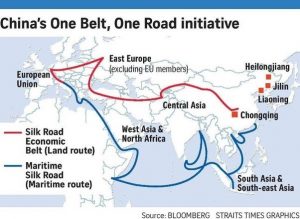 World leaders are divided about the motivation of the Chinese Government and some countries could be described as being wary (UK, USA, Germany) and interestingly most of the G7 leaders opted out of an invitation to attend a meeting in May to discuss the plan. However this major project has the blessings of Russia, Pakistan and 28 other Heads of State’s . It will be interesting to see if the Silk Road will become the lucrative, economic trading route as envisaged.
World leaders are divided about the motivation of the Chinese Government and some countries could be described as being wary (UK, USA, Germany) and interestingly most of the G7 leaders opted out of an invitation to attend a meeting in May to discuss the plan. However this major project has the blessings of Russia, Pakistan and 28 other Heads of State’s . It will be interesting to see if the Silk Road will become the lucrative, economic trading route as envisaged.
Either way the re-establishment of this ancient route will attract attention, for the hundreds of thousands of people who seek adventure, hikers, back packers, runners, cyclists and a host of people who want to explore the beautiful, exotic, culturally rich lands, where the Silk Road passed through for thousands of years.
I was very excited about the prospect of visiting universities in Tajikistan and Uzbekistan as part of the European Union International Credit Mobility (ICM) Program from the 9th-24th of August 2017. ICM is the European Union funding programme, which allows staff and students from EU countries to visit countries known as “Partner Countries” under EU funding rules. These are countries, which are located outside the European Union taking for example countries such as Albania, Bosnia and Herzegovina, Kosovo, Montenegro in the Western Balkans, South American countries or as in this case- Central Asian countries Tajikistan and Uzbekistan.
These are fantastic opportunities for staff and students of Higher Educational Institutions, who want to “dip their toe” into what it is like to get involved with other universities in a variety of countries- a unique opportunity for collaboration and networking on an international scale.
In the context of funding European Union (EU) programmes, the EU create ring-fenced budget envelopes focussed on various regions funding projects for example in South Mediterranean Countries (e.g. Jordan, Lebanon), Eastern Partnership Countries (e.g. Armenia, Georgia, Belarus) and the Russian Federation. Another region that features prominently in EU funding programmes is the Western Balkans. This is a region in which I have worked extensively in the past 10 years as Project Leader of various EU funded projects in countries Albania, Bosnia and Herzegovina, Kosovo and Montenegro in projects dealing with areas such as Information Literacy and Library modernisation.
In recent years, the EU have been opening its funding programmes and Calls for Proposals to new regions and indeed continents such as Asia (e.g. China, Vietnam), Central Asia (Uzbekistan, Tajikistan), Latin America, the Middle East and South Africa. There are also mobility opportunities in Industrialised countries such as Industrialised Asia and North America along with opportunities in Africa, Caribbean and Pacific countries. (For more information, see note 1 below)
It important to note that under EU funding programmes such as International Credit Mobility (ICM), that mobility’s can be both Incoming to Europe and Outgoing from Europe. In the case of ICM projects the budgets for the external cooperation and to enable the mobility’s are managed by EU partners who disburse the funds accordingly to the Partner Countries (those countries outside the EU). So it’s important that applicants read the terms and conditions and importantly the EU external priorities when applying.
ICM programs are also a great experience for new members of Library and Information Science (LIS) Schools or Departments to start their journey into the world of EU funded programmes. In many ways, programmes such as ICM which have relatively smaller budgets (usually around 30K split between all partners) are an excellent stepping-stone into the larger, more complex multi-country programmes such as Capacity Building in the Field of Higher Education (CBHE). These CBHE projects can have budgets of up to 1 million euros per project and it is not uncommon for the Project Consortium to be comprised of up to 20 Partner universities. ICM programmes help those endeavouring to chart new territory in the EU programme arena by giving them the opportunity to travel abroad, to meet the key people in their field, to start making contacts and most importantly to help them build their network. Building quality, resilient networks is vital if one wants to go on to submit quality, winning applications for projects under larger Erasmus + programmes such as CBHE.
I would encourage new graduates of LIS to get involved in either Erasmus exchange projects such as ICM or later to get involved in more comprehensive Erasmus + projects such as CBHE. There, are many benefits to becoming more active in EU funded projects and programmes. Here are a few of the main benefits;
New opportunities, new encounters
You will get a taste of what is involved in collaborations, meeting new colleagues, seeing their work practices, showing yours, maybe even coming up with new methods, which you did not think about before the mobility. This will help to make you more effective in your work and will make you more aware of diversity and cultural awareness.
Financial Support
Mobility’s are, financially supported by the EU, for incoming to Europe or outgoing from Europe. There is a grant available; the amount often depends on the region or country you are going to, it covers most of your daily expenses such as flights, hotels, food etc.
You will not get rich, however for the mobility’s I undertook in Tajikistan and Uzbekistan the grant was more that generous.
Networking
After undertaking a few exchanges within Erasmus + projects such as ICM, you will find your friendships with new colleagues expanding. Perhaps the most striking effect is that each exchange builds on your last, each project brings more diverse experiences and colleagues to your network and your network builds. You will also find that the networks you create inevitably begin to encounter and embrace other networks and before long owing to the multiplier effects; you will have an international network of friends and collaborators from all around the World.
Travel
Anyone who has read my other blog posts will see that my involvement in EU projects has brought me around the World. Travel is the one thing, which gives, more that it takes. It enriches you, every time. The memories, encounters, the challenges, the trust, which you must have, and you must give is extremely rewarding. Traveling expands your life’s horizons and enriches your life’s experiences. Getting involved, helping others in developing countries to build their educational system as a student, a teacher, a lecturer or as a librarian is a good thing. Traveling should not, just be measured in miles or kilometres but in memories.
My trip via this mobility involved visits to some of the largest universities in Tajikistan and Uzbekistan in its major cities, Dushanbe in Tajikistan and the cities of Tashkent, Samarkand and Bukhara in Uzbekistan. From the 9th-16th of August I was in Tajikistan where I spent a number of days delivering library and information literacy training to library and academic staff in the capital city of Tajikistan- Dushanbe.
My hosts in Dushanbe from the 9th-16th of August was Tajik National University (TNU) - which is the largest university in Tajikistan with over 23,000 students. Described by some as a city in rapid transition from its original Soviet incarnation, in Dushanbe I visited both University and public libraries in the city. I met with Library Directors, to discuss possible cooperation between LIT and Tajik universities in EU funded programs and managed to find the time to take in some of the many museums and walk around the city to view some of its many monuments and sites.
I was also very pleased to visit Technological University of Tajikistan- a higher educational institution which educates and trains specialists in the field of technology, communications, economics and design in accordance with the license of the Ministry of Education and Science of the Republic of Tajikistan. The university has 9 faculties and more than 22 departments all situated in Dushanbe, which fulfils the full time education of more than 5,200 students in 39 different specialties. The university has about 250 teaching staff.
Undoubtedly, one of the least visited and least travelled places for experiencing the atmosphere of the ancient Silk Road is Uzbekistan, but it’s a must. Along with a fascinating and well-preserved history, travellers to Uzbekistan will find plenty of evidence of the Soviet influence on the country’s modern development. On the morning of August 13, I left Dushanbe heading to the ancient city of Samarkand in Uzbekistan- located on the Silk Road. In Samarkand, I visited the Tashkent University of Information Technologies (TUIT) Campus as well as Samarkand State University.
Today, the city of Samarkand is relatively quiet, known mostly for its magnificent medieval ruins. However, over a millennium ago, it was one of the richest cities on the Silk Road. As some commentators have noted- back in ancient times that route was called simply "the road to Samarkand." It has been centuries since anyone used the Silk Road as a major trade route, but its legend lives on in Samarkand. The city was one of the richest and best-known cities on the Silk Road. If you look at the map above, you can also see that Samarkand falls at a mid-point between Iran, India and Central Asia
From Samarkand, I travelled on to the city of Bukhara- sometimes referred to as a “Museum-city”, with about 140 architectural monuments. Bukhara is the fifth-largest city in Uzbekistan. Also located on the Silk Road, the city has long served as a centre of trade, scholarship, culture, and religion. Bukhara was one of the important educational and spiritual centres at the time of the Golden Age of Islam. Its compact city centre with a domed marketplace, mosques, and madrassas are a pleasure to explore on a city walk. It has one of the most important and oldest architectural monuments in Central Asia, the
 The Registan was the heart of the ancient city of Samarkand it is the main attraction in the City, beautiful place, with a dark history.
The Registan was the heart of the ancient city of Samarkand it is the main attraction in the City, beautiful place, with a dark history.
Architecturally, it is one of the country’s best-preserved cities with the majority of buildings dating from the 10th century onwards. Notably both the father and uncle of the famous explorer Marco Polo lived in Bukhara for a number of years before moving to the court of Kublai Khan. UNESCO has listed the historic centre of Bukhara as a World Heritage Site. In Bukhara I visited the Bukhara State University (BSU) and its library.
Not far from Bukhara, before travelling onwards on 16 August to Tashkent-the capital city of Tajikistan I had the pleasure of being invited to a traditional Uzbek wedding by my hosts from Tashkent University of Information Technologies (TUIT). The wedding was hugely enjoyable- with a cousin of one of our hosts from TUIT getting married. The wedding was attended by over to 1,000 people.
In Tashkent, the Tashkent University of Information Technologies (TUIT) one of the largest universities in Uzbekistan were my hosts. Tashkent is known for its distinguished Skyline and for buildings such as Tashkent Tower, as well as its many museums and its mix of modern and Soviet-era architecture.
In Tashkent, I meet with the Director of Library Services at TUIT to discuss possible further collaboration in EU programs and visited TUIT Library as well as other libraries in the city. I was delighted to be given the opportunity to visit such libraries as the Library of Tashkent University of Information Technologies and the National Library of Uzbekistan.
As part of the Social and cultural programme for the mobility I also had an unforgettable visit for sightseeing in the Chimgan mountains of Tashkent Region- including experiencing possibly the World’s scariest and least known cable car journey (more like sitting in a Chairoplane in a Fairground!) across a seemingly bottomless ravine! I would not recommend it, for anyone with a weak heart; it went on for 3Km, longest 3km I even spent.
I also had the opportunity to visit Lake Charvak - a water reservoir in Bostanliq District in the northern part of Tashkent Region-, which is also used extensively by Uzbeks for leisure activities such as bathing and water-skiing – an invaluable resource for a landlocked country located far from any Ocean.
Having spent a week in Tashkent, and before that in some of the most ancient cities in the world- Samarkand and Bukhara as well as Dushanbe in Tajikistan, I caught my flight from Tashkent Airport 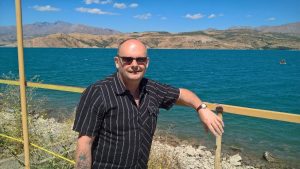 back to Dublin via Istanbul on the 24th of August. On the flight home I thought about the many interesting and productive encounters with Library Directors and Library staff in universities and libraries in Tajikistan and Uzbekistan during the visit- and the myriad of opportunities for collaboration that this might produce. Great opportunities for new entrances to LIS or existing Librarians.
back to Dublin via Istanbul on the 24th of August. On the flight home I thought about the many interesting and productive encounters with Library Directors and Library staff in universities and libraries in Tajikistan and Uzbekistan during the visit- and the myriad of opportunities for collaboration that this might produce. Great opportunities for new entrances to LIS or existing Librarians.
Indeed, on the professional level, these visits to Tajikistan and Uzbekistan provided an invaluable insight into the workings of University and National Libraries in Central Asian countries and their efforts to repurpose old Soviet institutional structures and roles for new ends. While these libraries are trying to grapple with such antiquated structures and associated problems such as old and obsolete book stocks and older collections generally. I found that library managers and staff are also very keen to embrace change and make the transition into the digital world of online databases, EBooks, Library Management Systems and Open Access and most importantly to engage in staff development and exchange programs.
The visit was also of great benefit for example in the context of Information Literacy (IL) where the term is still largely unknown when compared with the Western World where of course the term has been in wide circulation ever since Paul Zurkowski coined the phrase in 1974. In the West, while IL has been gaining momentum particularly during the 1990’s and into the 21st century, by contrast in Tajikistan and Uzbekistan, Information Literacy still has quite a journey to go. However, from my experience, both Professors and Librarians are now very keen to embrace the concept, particularly in the light of the problem of plagiarism which it appears is not only an issue among students but even among the academic staff themselves and sometimes at the highest levels.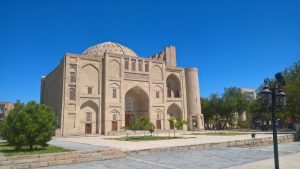
As a Project Leader of EU funded projects, I have participated in a number of projects dealing with the area of improving access to libraries, education and Society in general for people with disabilities most notably in countries such as Armenia, Georgia as well as Moldova and Belarus. In this context also, the visit proved both fascinating and challenging. Similar to my experience in these aforementioned countries, services and initiatives to assist people with disabilities to access education in both Tajikistan and Uzbekistan are quite poor and indeed are at a lower level than in countries such as Armenia and Georgia. There are serious problems with basic infrastructure such as access to libraries and buildings and most libraries prove completely unnavigable and unsuitable for people with disabilities. Generally, there is a lack of awareness to cater for people with disabilities even down to simple issues such as signage, access to books on shelves and the absence of the most basic assistive technologies.
On the journey home, I reflected also on the many wonderful qualities that these Central Asian countries possess. These include the greatness of the mountains, the beauty of rivers and lakes, the deserts, its amazing cuisine, which is delicious, with most importantly, natural fruits and vegetables. These are countries with an original culture full of interesting customs and traditions. But most importantly, the Region is famous for its people- hospitable, peaceful, friendly and from my experience; the Region certainly lives up to its reputation!
slán agus buíochas a ghabháil leat (goodbye and thank you)
If you would like any information about getting involved in Erasmus Exchange or if you have any other comments, please just let me know
Thanks for reading
Jerald
Bibliography
One Belt on Road, Website https://qph.ec.quoracdn.net/main-qimg-f3fa15ea0ae76dbe5c4ed18e67f36e2f-c Accessed on the 20 Sept 2017. Source https://www.quora.com/What-is-One-belt-one-road-china
The Lost Empire that Ruled the Silk Road, Website https://io9.gizmodo.com/sogdia-the-lost-empire-that-ruled-the-silk-road-1553078058 Accessed on the 21st Sept 2017.










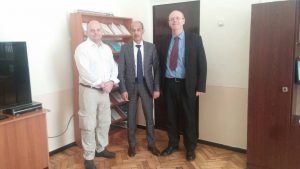


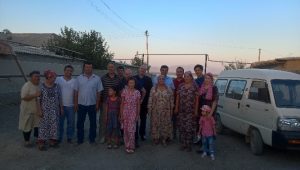
lyn
Lovely, narrative and stunning photos!
David Bawden
Excellent post. So right about the importance of Erasmus and similar exchange programmes for students and academics … and vital that Brexit is not allowed to disrupt them for the UK